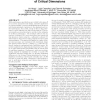Free Online Productivity Tools
i2Speak
i2Symbol
i2OCR
iTex2Img
iWeb2Print
iWeb2Shot
i2Type
iPdf2Split
iPdf2Merge
i2Bopomofo
i2Arabic
i2Style
i2Image
i2PDF
iLatex2Rtf
Sci2ools
94
Voted
DAC
2005
ACM
2005
ACM
Advanced Timing Analysis Based on Post-OPC Extraction of Critical Dimensions
While performance specifications are verified before sign-off for a modern nanometer scale design, extensive application of optical proximity correction substantially alters the layout introducing systematic variations to the simulated and verified performance. As a result, actual on-silicon chip performance is quite different from sign-off expectations. This paper presents a new methodology to provide better estimates of on-silicon performance. The technique relies on the extraction of residual OPC errors from placed and routed full chip layouts to derive actual (i.e., calibrated to silicon) CD values that are then used in timing analysis and speed path characterization. This approach is applied to a state-of-theart microprocessor and contrasted with traditional design flow practices where ideal (i.e., drawn) Lgate values are employed, leading to a subsequent lack of predictive power. We present a platform for diagnosing and improving OPC quality on gates with specific functionality ...
| Added | 13 Nov 2009 |
| Updated | 13 Nov 2009 |
| Type | Conference |
| Year | 2005 |
| Where | DAC |
| Authors | Puneet Gupta, Andrew B. Kahng, Youngmin Kim, Dennis Sylvester |
Comments (0)

